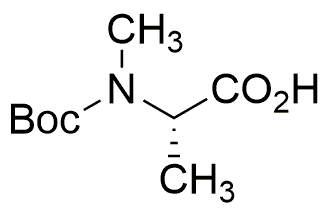Boc-N-methyl-L-alanine is widely utilized in research focused on:
- Peptide Synthesis: This compound serves as a key building block in the synthesis of peptides, particularly in the development of therapeutic proteins and enzymes.
- Drug Development: It is used in the design of novel pharmaceuticals, especially in creating compounds that target specific biological pathways, enhancing efficacy and reducing side effects.
- Biotechnology: Researchers employ it in the production of modified amino acids, which can improve the stability and functionality of biotechnological products.
- Research in Neuroscience: The compound is explored for its potential roles in neurotransmitter modulation, aiding studies on brain function and disorders.
- Analytical Chemistry: It is utilized in various analytical techniques to study protein interactions and modifications, providing insights into molecular behavior.
General Information
Properties
Safety and Regulations
Applications
Boc-N-methyl-L-alanine is widely utilized in research focused on:
- Peptide Synthesis: This compound serves as a key building block in the synthesis of peptides, particularly in the development of therapeutic proteins and enzymes.
- Drug Development: It is used in the design of novel pharmaceuticals, especially in creating compounds that target specific biological pathways, enhancing efficacy and reducing side effects.
- Biotechnology: Researchers employ it in the production of modified amino acids, which can improve the stability and functionality of biotechnological products.
- Research in Neuroscience: The compound is explored for its potential roles in neurotransmitter modulation, aiding studies on brain function and disorders.
- Analytical Chemistry: It is utilized in various analytical techniques to study protein interactions and modifications, providing insights into molecular behavior.
Documents
Safety Data Sheets (SDS)
The SDS provides comprehensive safety information on handling, storage, and disposal of the product.
Product Specification (PS)
The PS provides a comprehensive breakdown of the product’s properties, including chemical composition, physical state, purity, and storage requirements. It also details acceptable quality ranges and the product's intended applications.
Certificates of Analysis (COA)
Search for Certificates of Analysis (COA) by entering the products Lot Number. Lot and Batch Numbers can be found on a product’s label following the words ‘Lot’ or ‘Batch’.
Numéro de catalogue
Numéro de lot/série
Certificates Of Origin (COO)
This COO confirms the country where the product was manufactured, and also details the materials and components used in it and whether it is derived from natural, synthetic, or other specific sources. This certificate may be required for customs, trade, and regulatory compliance.
Numéro de catalogue
Numéro de lot/série
Safety Data Sheets (SDS)
The SDS provides comprehensive safety information on handling, storage, and disposal of the product.
DownloadProduct Specification (PS)
The PS provides a comprehensive breakdown of the product’s properties, including chemical composition, physical state, purity, and storage requirements. It also details acceptable quality ranges and the product's intended applications.
DownloadCertificates of Analysis (COA)
Search for Certificates of Analysis (COA) by entering the products Lot Number. Lot and Batch Numbers can be found on a product’s label following the words ‘Lot’ or ‘Batch’.
Numéro de catalogue
Numéro de lot/série
Certificates Of Origin (COO)
This COO confirms the country where the product was manufactured, and also details the materials and components used in it and whether it is derived from natural, synthetic, or other specific sources. This certificate may be required for customs, trade, and regulatory compliance.


